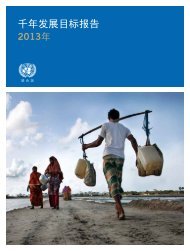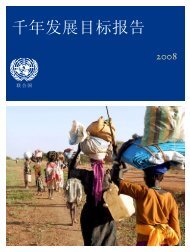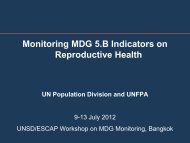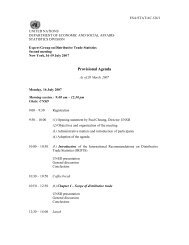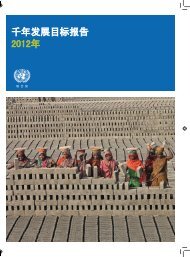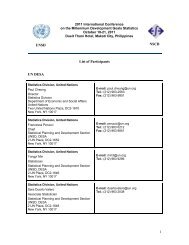demographic yearbook annuaire demographique 1951
demographic yearbook annuaire demographique 1951
demographic yearbook annuaire demographique 1951
Create successful ePaper yourself
Turn your PDF publications into a flip-book with our unique Google optimized e-Paper software.
from the previous lists. 6 The new classification serves a dual<br />
purpose-to classify causes of illness as well as causes of<br />
death for statistical use. As an extension of the mortality<br />
list to serve also as a morbidity list, it necessarily differs<br />
considerably from the previous lists. However, the general<br />
structure of the old classification has been preserved because<br />
of the demonstrated usefulness of the basic framework.<br />
The Sixth Revision detailed list consists of 16 sections<br />
subdivided into 612 categories of diseases and morbid conditions,<br />
plus an additional section concerned with injuries<br />
and consisting of a dual classification which provides 153<br />
categories for the classification of external causes and 189<br />
categories for the characterization of injuries according to<br />
the nature of the injury. Provisions are made for securing<br />
still more detailed information by further subdivisions of<br />
many of the categories. However, the use of these subdivisions<br />
by nations is optional.<br />
The detailed list is prescribed for classification purposes,<br />
but the following special lists are also provided for tabulation<br />
and publication purposes: (1) an intermediate list of<br />
150 causes for tabulation of morbidity and mortality by age<br />
groups and other <strong>demographic</strong> characteristics; (2) an abbreviated<br />
list of 50 causes for tabulation of mortality in administrative<br />
subdivisions; (3) a special list of 50 causes for<br />
tabulation of morbidity for social insurance purposes.<br />
PROBLEMS OF JOINT-CAUSE CLASSIFICATION<br />
The production of statistics on causes of death is relatively<br />
simple when only one clearly defined morbid condition is<br />
involved. However, when complications of a disease arise,<br />
or when there is an intercurrent infection, more than one<br />
condition may contribute to death. In such cases, either the<br />
medical certifier or the statistical office is faced with the<br />
necessity of selecting a single cause for statistical tabulation.<br />
Variations in selection procedures<br />
It was with this problem in mind that Jacques Bertillon<br />
appended to the 1900 revision of the International List of<br />
Causes of Death a commentary noting the most frequent<br />
complications of each important disease and indicating<br />
those complications which need not be taken into account.<br />
He also developed the following general rules to be followed<br />
when two or more causes of death were reported jointly:<br />
"Rule 1. Ifone of the two diseases is an immediate and<br />
frequent complication of the other, the death<br />
should be classified under the head of the<br />
primary disease.<br />
"Rule 2. If it is not absolutely certain that one of the<br />
diseases is an immediate result of the other,<br />
we must see if there is a very great difference<br />
in the gravity of the two, and classify the<br />
death under the head of the more dangerous.<br />
"Rule 3. When among the two causes of death there<br />
is a transmissible disease, it is preferable to<br />
assign the death to it, for statistics of infectious<br />
diseases are particularly interesting to<br />
the sanitarian, and it is important that they<br />
shall be as complete as possible.<br />
"Rule 4. If a disease whose evolution is rapid is given<br />
in connection with another whose evolution<br />
6 World Health Organization, Manual oj the International Statistical<br />
Classification oj Diseases, Injuries and Causes oj Death, Vol. I and II,<br />
Geneva, 1948.<br />
is slow, it is preferable to charge the death to<br />
the first. Again, if a death is simultaneously<br />
attributed to a disease and to an external<br />
violence, it is usually proper to assign it to<br />
the latter.<br />
"Rule 5. Finally, if none of the preceding rules is<br />
applicable, the diagnosis most characteristic<br />
of the case should be selected." 7<br />
These rules have long served as guides for many national<br />
statistical offices, though, as a result of their rather general<br />
character, the specific manner in which they have been<br />
applied has varied considerably. Thus, a report by Michel<br />
Huber, prepared in 1926, showed that while the specific<br />
rules differed greatly, most countries accorded precedence<br />
to the causes of violent death, to infectious diseases, and to<br />
diseases most frequently causing death, in the order named. 8<br />
But the major weakness in such general rules is the absence<br />
of a definitive procedure for selecting the principal or primary<br />
cause of death.<br />
The findings of a questionnaire survey made in 1947 by<br />
the United States Committee on Joint Causes of Death 9<br />
were similar to those reported by Huber twenty years earlier.<br />
Some progress had been made in the adoption of<br />
medical certification forms designed to record the physician's<br />
opinion on the sequence of events leading up to death<br />
so that the various contributing causes could be evaluated.<br />
However, there seemed to have been few developments of<br />
definite rules of procedure for selecting the main cause of<br />
death. Many of the countries apparently had no rules at all<br />
or only a few very general rules; on the other hand, some<br />
countries had adopted a comprehensive set of rigid rules<br />
(e.g., the Manual of Joint Causes of Death, adopted by the<br />
United States; also, the procedures developed in England<br />
and Wales, which provided the basic pattern for the international<br />
rules adopted in 1948).<br />
The application of different procedures would obviously<br />
produce different results. The extent of these differences was<br />
demonstrated in a study made in 1935. 10 The United States<br />
Bureau of the Census, at the request of the Commission for<br />
Revision of the International List of Causes of Death, prepared<br />
descriptions of 1,032 cases, each involving from two<br />
to five causes of death. These cases were submitted to the<br />
statistical offices of various countries with the request that<br />
they be classified according to the selection principles followed<br />
currently in those offices. The analysis of the returns<br />
included data for 18 countries.<br />
The return of each country was compared, cause by<br />
cause, with that of each of the others and percentages of<br />
agreement were computed on the basis of each comparison<br />
for each cause and for all causes combined. (One group,<br />
involving deaths of infants under one year of age, was<br />
treated as a separate category). As shown in the table below,<br />
the overall average agreement in the selection ofthe primary<br />
cause of death in the 1,032 cases was only 57.5 per cent.<br />
7 United States Census Office, Manual oj International Classification<br />
oj Causes oj Death, Government Printing Office, Washington, 1902,<br />
page 13.<br />
8 Huber, Michel, "Report on Methods of Issuing Certificates of<br />
Death and Its Causes," Bulletin de l'Institut International de Statistique,<br />
Vol. 22, Livr. 3, The Hague, 1926, pages 23-66.<br />
9 World Health Organization, Problem oj Joint Causes oj Death, Final<br />
report oj the United States Committee on Joint Causes oj Death. WHO.IC/<br />
MS/11, Rev. 2.<br />
10 United States Bureau of the Census, Classification ofJoint Causes<br />
of Death. Vital Statistics-Special Reports, Vol. 5, No. 47, August 30,<br />
1938, Washington, 1938.<br />
20






